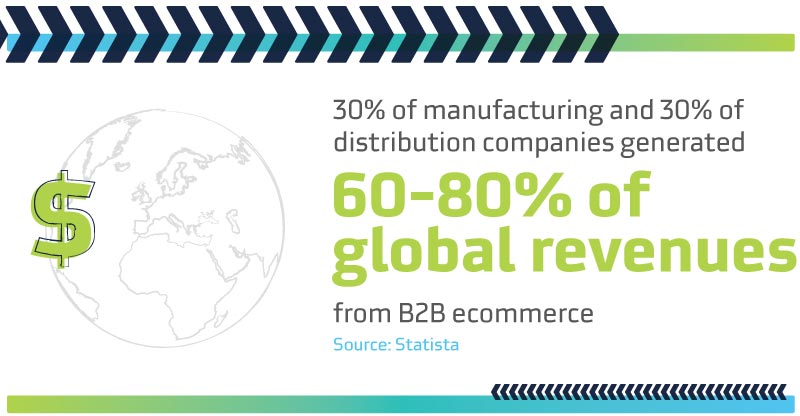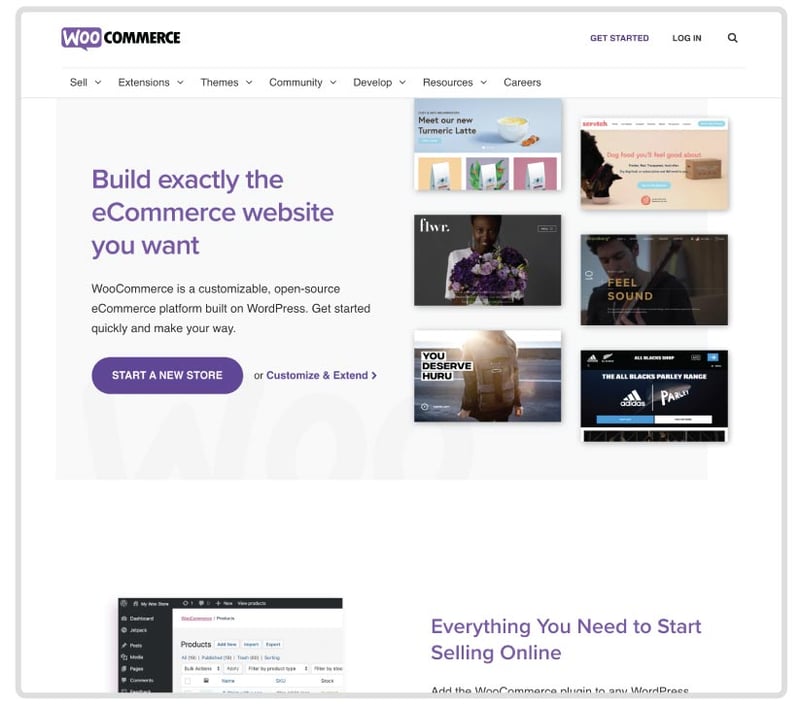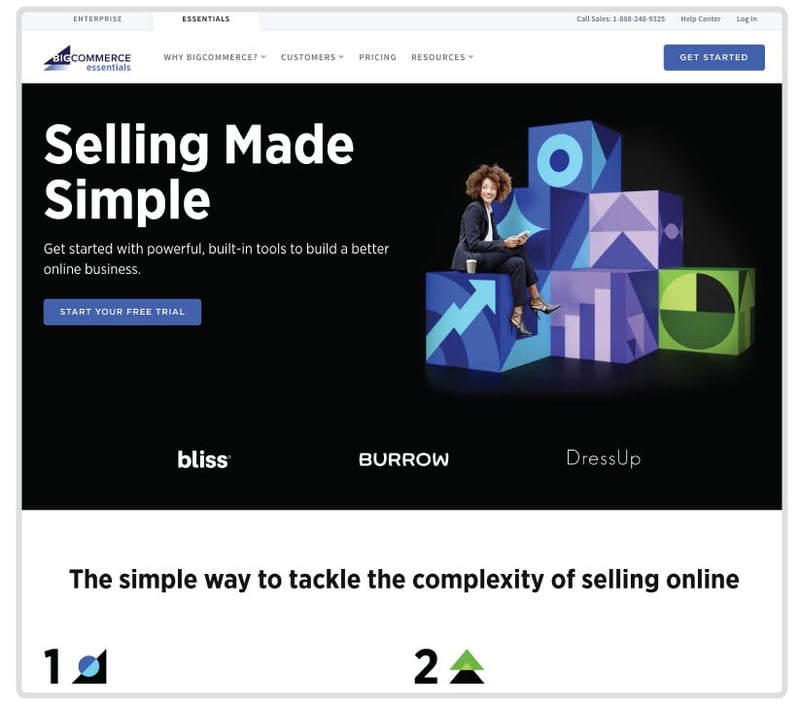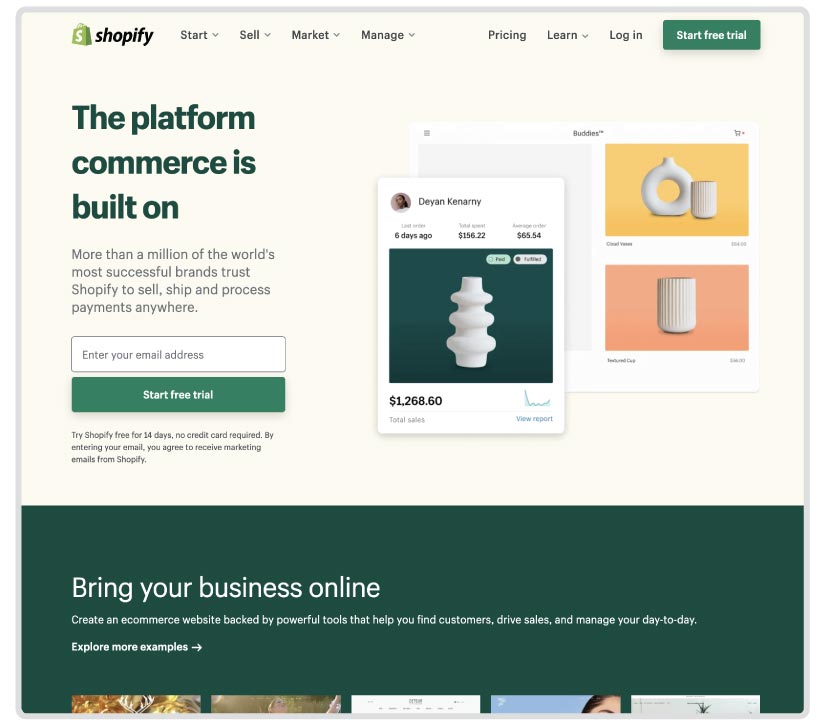Choosing an Ecommerce Website for Your Manufacturing Company
 Taylor
|
Taylor
|

Boost sales and outpace competitors with a user-friendly B2B ecommerce website.
For many years, we’ve seen B2B manufacturing and industrial companies avoid selling their products online. Often the concerns we heard were that it was too complex, too high-risk, or the ROI was too low. But, in recent years, several leaders have started to rethink this position. As a matter of fact, Forrester forecasts U.S. business-to-business ecommerce transactions to reach $1.8 trillion by 2023, accounting for 17% of all B2B sales in the country.
Growth forecasts like this are driven by companies doing whatever they can to outpace their competitors to win business. In fact, companies that adopted an ecommerce presence were surprised by the increase in purchases. In March 2020, 30% of manufacturing and 30% of distribution companies generated 60-80% of their global revenues from B2B ecommerce.

Since then, more B2B businesses in the manufacturing industry have added ecommerce capabilities to their business models as an additional distribution strategy. Additionally, with the growth and normalization of B2C ecommerce over the past few years, B2B buyers have now come to expect the same convenient and high-quality experience from business-to-business companies.
If you’ve decided that adding ecommerce capabilities to your business’ marketing strategy would help you boost sales and outpace competitors, there’s no better time to make a move. While there are dozens of things to consider when getting an ecommerce website up and running, there are a few key criteria that you’ll need to think about that will have an impact on the success of your B2B ecommerce business.
Understand your audience and how they’re searching.
As a B2B manufacturer, you're catering to a smaller audience that typically has specific needs and requirements. And while they often know they have a need, they don't always know what solutions are available or which is best for them.
Nobody understands your product and its benefits better than you. So, it's essential that you bridge the knowledge gap between your customers' needs and the right solution for them. Your role is vital because they may not make that connection on their own.
How do you identify your target audience? How can you know their needs? Which of your products is the best solution? Finding the answer to these questions may seem overwhelming or time-consuming, but there are surprisingly easy ways to gain insight into each.
Here are a few ideas to get you started on understanding your audience.
See what your competition is doing.
- What type of experience are they offering their customers?
- What works well about how they sell their products? What doesn’t?
- What messaging strategy are they using?
- How do they navigate customers to their products?
- What product information do they make available?
Map out your sales cycle and processes.
- Identify the lifecycle of your customers.
- Map out the steps in your sales cycle.
- Map out enter/exit criteria (what it takes for a customer to enter and exit each stage).
- Outline major pain points or questions customers have during each stage.
- Define any common questions your sales team frequently answers during the sales cycle.
Upkeep accurate and consistent product data.
Once you have a clear understanding of who your audience and customers are, you can move on to your product and ecommerce website definition. One of the biggest challenges we see B2B manufacturing companies face when transitioning to online ecommerce selling is product definition and clarity.
All too often, when companies start to grow, product information gets stored in a variety of locations. Some information is kept in separate spreadsheets, other data is housed in the accounting software, some details are tracked in shipping software, and the list could go on. If this sounds like you, don’t worry. This is a common growing pain for many growing manufacturers. Setting up an ecommerce website for your products is an excellent way to get your product data cleaned up and in one place.
First, we’d recommend collecting all your product offerings in one list. Then from there, you can separate that list into two categories:
- Products available for instant online shopping
- Products available through in-person sales or sales representatives
Next, gather complete information and data for the products that are available for online shopping. Here are some ideas of standard details that manufacturers require when updating product information for ecommerce stores.
- Product SKU/Item #
- Product Name
- Price
- Weight
- Product Description
- Shipping Price
It’s important to get a complete picture of every product available in your online store. Incomplete data can leave your customers frustrated or confused. Accurate and consistent product information allows you to set up an online shopping experience that generates a constant sales flow.
Schedule A Free Ecommerce Consultation
Invest in an ecommerce platform built for B2B.
It’s time to get to the part we’ve all been waiting for — building your B2B ecommerce website. It may seem like it took a minute to get here, but the better you define information upfront, the quicker your ecommerce site can be built. And the sooner it’s built, the sooner you can promote this new revenue source.
There’s a wide variety of B2B ecommerce solutions available in the marketplace today, even ones flexible and versatile enough for manufacturing businesses. You could choose a fully customizable system, but there are also many user-friendly ecommerce solutions that allow you to get started without starting from scratch. There are a couple of questions you can ask yourself when deciding which solution is the right fit for your manufacturing company.
- Do you need enterprise-level solutions and integrations?
- Do you need the ability to set custom minimum order quantities or add bulk discounts?
- Do you need wholesale order forms and wholesale pricing?
- Do you need to access restriction options to hide certain areas of your website (e.g., pricing for custom product configs)?
- Do you need to adjust product catalogs and pricing for different customer segments?
- Do you need integrated payment processing and flexible payment options?
- Do you need your ecommerce store integrated into additional software like accounting or CRM?
Below we’ve summarized our top three manufacturing ecommerce recommendations and provided several pros and cons for each. This information should help you decide which is best for your needs and business model.
WooCommerce
This platform runs exclusively on WordPress as a simple plug-in. When using WooCommerce, WordPress themes must be compatible or the plug-in won’t work. The most significant benefit to WooCommerce is that since it’s open-source, meaning the plug-in itself is free, but you will have to pay for transaction fees. WooCommerce has specific integrations designed to help manufacturers sell online and control their website business. The secret to success with WooCommerce is making sure you have a high-quality hosting service and that you’re working with a skilled developer.

Pros:
- WooCommerce and WordPress are both open source and can be enhanced via WordPress plug-ins and WooCommerce extensions
- Large developer pool
- WordPress CMS is highly customizable for marketing content
- Simple and intuitive dashboard tools
Cons:
- Enhancing a site with numerous plug-ins or extensions may increase the site’s complexity and potentially cause maintenance problems as the plug-ins and extensions independently evolve
- A large developer pool, combined with a low barrier to entry, can result in quality problems if you hire an inexperienced developer
- With some installations, WooCommerce exists on your hosting server, which makes related liability a concern
BigCommerce
BigCommerce is available as a subscription service as well as standalone software. Its interface is easy-to-navigate and usually up and running in relatively quick turnaround times. BigCommerce can be optimized for manufacturing ecommerce and can easily be customized to create branded and functional online stores.

Pros:
- No transaction or setup fees
- Unlimited staff accounts (ideal for large companies)
- Plans include unlimited bandwidth, products, and storage space
- Can download theme files to edit offline
Cons:
- A small selection of free themes
- You must upgrade to a more expensive plan if you surpass the annual sales threshold associated with your plan
- Recurring billing isn’t available for the basic plan
Shopify
Shopify is a subscription-based software that is capable of catering to small inventory all the way up to large, commercial inventory. It can easily handle large product volumes and fluxes in site traffic. The good thing about Shopify is that it offers online retailers including manufacturers a collection of extensions, plug-ins, and themes that makes building and using the website secure and easy. Overall, Shopify is known for its relatively low implementation costs and comes with several service options.

Pros:
- Intuitive interface
- Low monthly cost and more economical by comparison
- Online support from the platform
- Extensive, easy-to-use online documentation
- Large developer pool
- Broad API support
- Well supported tools for integrating ecommerce features into outside websites
Cons:
- Limited marketing content customization
- Cannot customize payment gateway or checkout process
- Business logic sometimes won’t accommodate your needs
Turn your B2B ecommerce vision into reality.
Industrial and manufacturing businesses are looking for ways to grow faster than ever and are open to adding new distribution channels to their strategy. By implementing an ecommerce platform, B2B customers can shop and purchase 24/7 without waiting on a sales rep, and B2B businesses can boost sales with the new source of revenue.
Are you ready to turn your ecommerce vision into reality? If so, let's talk. As a leading B2B marketing agency and expert in B2B ecommerce website solutions, it's our mission to help growth-minded businesses generate the marketing and sales traction they need to drive their business forward.
Why wait any longer? Position your B2B manufacturing business to increase sales and outpace the competition. Starting is easy. Schedule a free, no-obligation consultation today, and we'll offer recommendations and clear next steps that will give you an ecommerce website that looks great and makes you money.
Subscribe to Our Blog
Stay up to date with the latest marketing, sales, and service tips.
